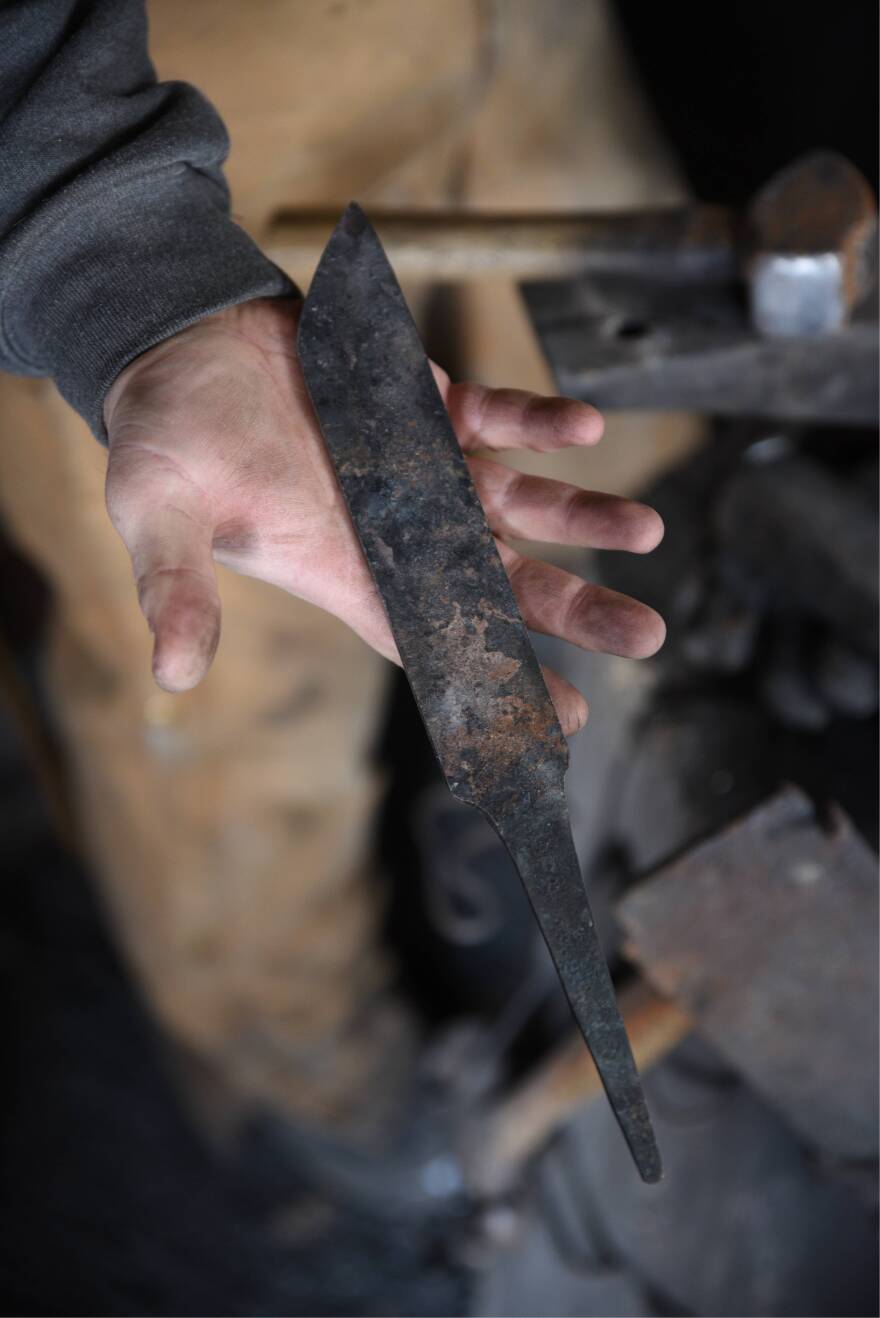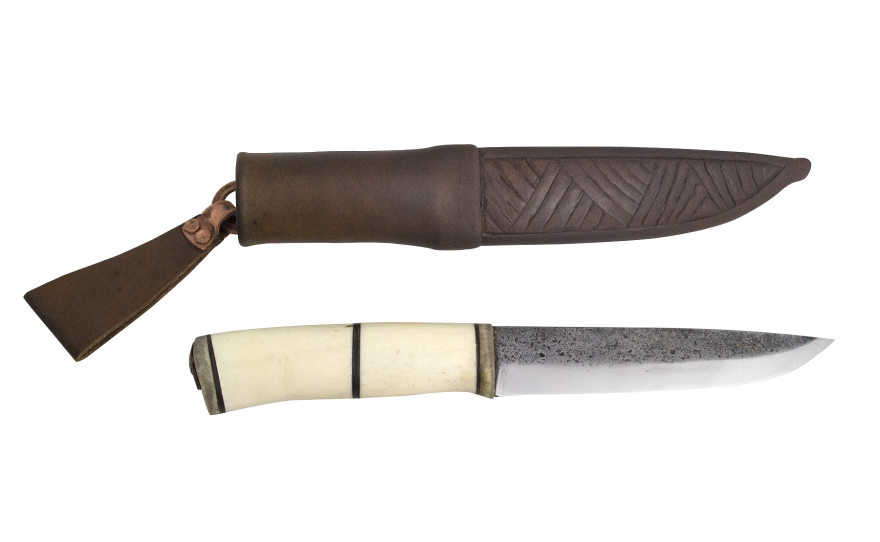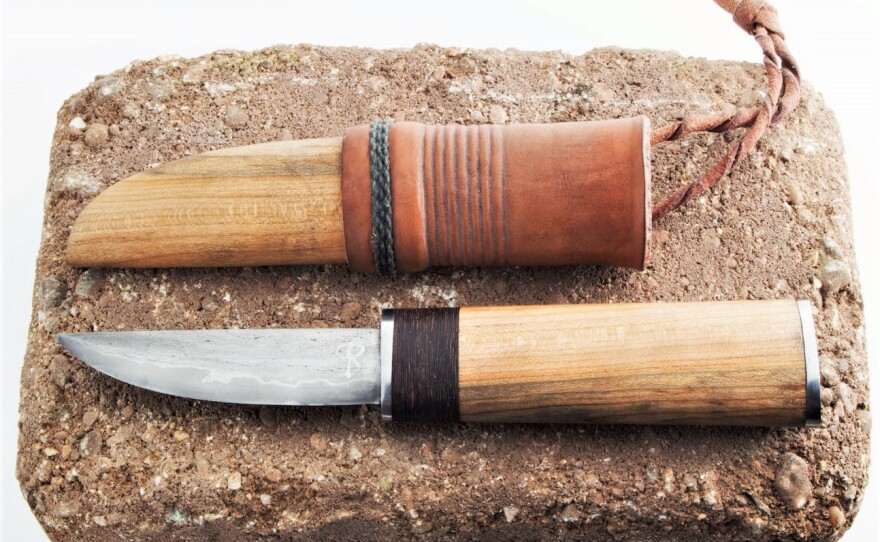
The first thing you hear is the sound of the blacksmith pumping the bellows to make the fire in the forge hotter.
We’re at the Delano Homestead at the Kalamazoo Nature Center because there’s a small shed where a volunteer shows visitors how a homestead blacksmith might work. But he’s better known for what he forges. His name is Gabriel Paavola.
GP: "A good Finnish name."
LG: "What do you make?"
GP: "I make knives, puukos and leukus (see examples in the slideshow above)."
LG: "All right, you'll have to explain those."
GP: "Okay. Puuko is a traditional Finnish knife and it's your basic everyday carry knife. It's used for anything from dispatching deer to fish. You can even use them to make kindling for starting fires. And then, leuku is a bigger version. It's used more in lieu of an axe, but it can also do the very same thing that you need from a knife rather than an axe."

LG: "Why those kinds of knives?"
GP: "Well I'm a Finnish Yooper (a native of Michigan's Upper Peninsula) and I grew up with those types of knives. In recent years, they became really popular with the bushcraft community because they are so light to carry and you can use them for a lot of different things. I mean, they're your original multipurpose tool and knife. And it stood the test of time for centuries and the cold north. So those, for me, I'm kind of reconnecting with ancestral roots, but they just make sense to me rather than buying all the bells and whistles you get from your Rambo type knives or whatever."
LG: "You're saying you're trying to connect with your ancestral roots and a lot of people who, you know, say they're Scottish, will buy a kilt rather than make a kilt. Why aren't you just buying the knives instead of making them?"
GP: "Sisu."
According to Finlandia University in Hancock, Michigan, for the Finnish people, “sisu” has a mystical, almost magical meaning. It is a Finnish term that can be roughly translated into English as strength of will, determination, perseverance, and acting rationally in the face of adversity. Sisu is not momentary courage, but the ability to sustain that courage. It is a word that cannot be fully translated. It stands for the philosophy that what must be done will be done, regardless of cost. Keep that in mind as we talk to Paavola.
GP: "I'm really stubborn. You know, I started learning blacksmithing about 22 years ago now. Took my first class at Northern Michigan University. I was always fascinated with the blade, with the sword. It's a tool that you really can't improve upon. It just does the job that you need done. And so I went off (and) learned swordsmithing. And then, you know, that experience really kind of left me walking away from bladesmithing. I just didn't want to do it because I'm, you know, a lot of factors. But, do your research on who you learn from. Because often if it seems too good to be true, it is."

It wasn’t until about eight years ago that he started getting back into bladesmithing. He just couldn’t shake the feeling that he was called to make knives and swords.
GP: "If you're called to be an accountant, be an accountant. There is nothing wrong with that. I believe, and I believe this to my core, is that we all have a gift. We all have something we do. And we may not be the best at it, but it's what inspires us to be the best we can. If we can use that ability, that gift, to try and improve the lives of those around us, do that thing. I don't advise anyone being crazy enough to try and pick up bladesmithing because it's a huge investment. The saying of, you know, to make a million dollars in bladesmithing you got to start with two million is quite true."
LG: (laughing) "I've heard that about other professions as well."
GP: "This is no different. Depending on how you scale up or scale down, it's going to cost you either time or money. Or all of both. But, whatever is your passion, you gotta do it."

Because of a show called "Forged in Fire" on the History channel, bladesmithing has become a lot more popular. The show's in its sixth season. But Paavola says there’s no concern yet about competition. There are so many different people who want a custom blade. He’s sold to musicians, foresters, sculptors, school teachers, hunters, and more.
Paavola uses steel he salvages from things such as old farm equipment or even steel cable. He could use steel stock instead and it actually would be easier in the long run.
GP: "The one factor you don't want when you're starting out is: was this reclaimed steel? Because there could be stress fractures already put into it just from when it was used. I probably lose about every fourth or fifth blade I pound out with reclaimed steel because of those stress fractures. Of course, you know, my human stupidity comes into play sometimes. But most of the time, it's because there was already some stresses in the steel. And you can see it if you're paying attention. Sometimes I'm rushing, don't even pay attention and it shows up later."
LG: "With that risk, why do it? I mean, if you're losing one out of every five blades, why use or up-cycle steel?"
GP: "There is a story to it. There's a history to it."

That history has to do with the origin of iron. He says as the universe formed and stars exploded, iron was a basic element in our earth. The poetry of iron in those celestial forges is something he keeps in mind. It took billions of years before that iron made its way to his forge. There’s a lesson in patience there which he embraces.
GP: "If you come to the forge with a bad attitude, with a lot of anger and frustration, all you're going to do is make a hunk of junk. You really have to, I can't believe I'm going to use these metaphors, but you got to purify yourself with the fire. Focus on what you're doing. Every strike is not haphazard. It's all thought out and coordinated. A lot of people see the hammer and anvil and they don't realize it's a process of pinching. No different than using Play-Doh. The reason why you use the anvil and hammer, obviously, is to not burn yourself and to still provide some force behind it but it moves the same way. You have to make it a kind of meditation, at least that's my process. I'm sure there are guys out there who just, you know, “Hulk smash,” and make really amazing stuff. But from any of the master Smiths that I've seen, they come at it with with a good attitude, a good mind, a good heart even when it's a bad day. And they just use the process to get rid of all that angst and create really amazing stuff."
LG: "Tell me about the handles, because you've got some beautiful handles."
GP: "Well, still trying. Uh, thank you. Well, being a Michiganian, and I will not say Michigander, there's one thing we have a lot of here: it's a lot of natural resources. I'd rather try and showcase what we have around here. I mean we have antler, we have plenty of wood, and you just got to know when to let it speak for itself. And you got to just go out there and harvest. And that's, I mean, that's the whole reason why I do this. If I can make a knife that makes someone feel empowered enough to go out and brave the wilderness and wild on their own, they might find out what's really amazing and special about this area."
Gabriel Paavola is with Ragged Raven Forge. See more examples of his work on his Instagram account here.
Support for arts and culture coverage comes from the Michigan Council for the Arts and Cultural Affairs.












